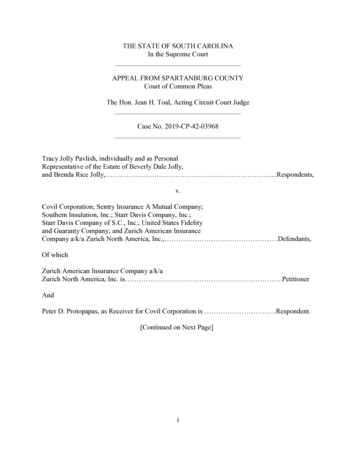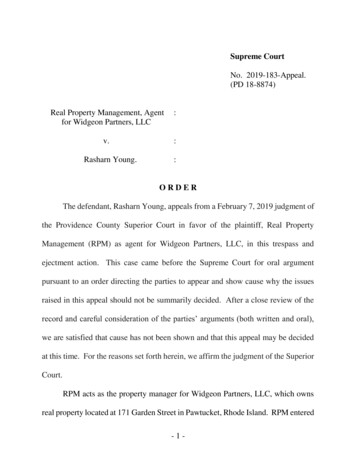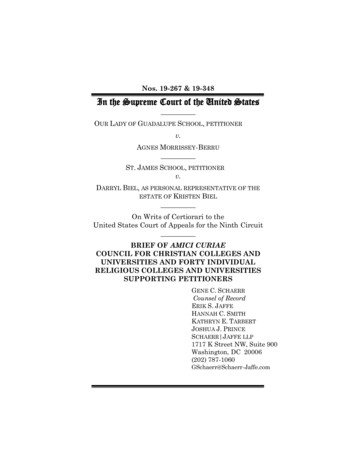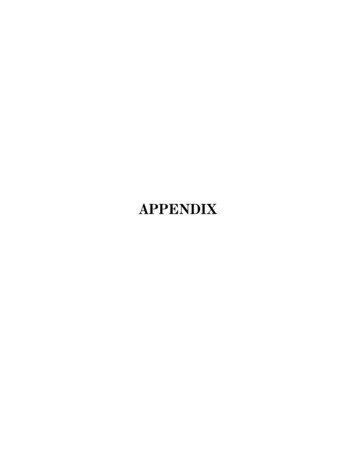
Transcription
APPENDIX
iTABLE OF APPENDICESAppendix AOpinion of the United States Court ofAppeals for the Federal Circuit(March 27, 2018). App-1Appendix BOrder Denying Renewed Motion forJudgment as a Matter of Law andMotion for a New Trial of the UnitedStates District Court for the NorthernDistrict of California(September 27, 2016) . App-56Appendix COrder Denying Rule 50 Motions of theUnited States District Court for theNorthernDistrictofCalifornia(June 8, 2016) . App-92Appendix DOpinion of the United States Court ofAppeals for the Federal Circuit(May 9, 2014) . App-121Appendix EOrder Partially Granting and PartiallyDenying Defendant’s Motion forSummary Judgment on CopyrightClaim of the United States DistrictCourt for Northern District ofCalifornia (Sept. 15, 2011) . App-193
iiAppendix FOrder on Motions for Judgment as aMatter of Law of the United StatesDistrict Court for Northern District ofCalifornia (May 10, 2012) . App-211Appendix GOrder re Copyrightability of CertainReplicated Elements of the JavaApplication Programming Interface ofthe United States District Court forNorthern District of California (May 31,2012) . App-212Appendix HFindings of Fact and Conclusions ofLaw on Equitable Defenses of theUnited States District Court forNorthern District of California (May 31,2012) . App-273Appendix IFinal Judgment of the United StatesDistrict Court for Northern District ofCalifornia (June 20, 2012) . App-277Appendix JOrder Denying Motion for Judgment asa Matter of Law and New Trial of theUnited States District Court for theNorthern District of California (July 13,2012) . App-280
iiiAppendix KOrder Denying Motion for Judgment asa Matter of Law and New Trial of theUnited States District Court for theNorthern District of California (Sept. 4,2012) . App-281Appendix LOrder on Petition for Rehearing EnBanc of the United States Court ofAppeals for the Federal Circuit(August 28, 2018) . App-283Appendix M17 U.S.C. § 101 . App-28517 U.S.C. § 102 . App-29817 U.S.C. § 107 . App-299
1aAppendix AUnited States Court of Appealsfor the Federal CircuitORACLE AMERICA, INC.,Plaintiff-Appellant,v.GOOGLE LLC,Defendant-Cross-Appellant.2017-1118, 2017-1202Appeals from the United States District Court for theNorthern District of California in No. 3:10-cv-03561WHA, Judge William H. Alsup.Decided: March 27, 2018***Before:Judges.O’MALLEY, PLAGER, and TARANTO, CircuitO’MALLEY, Circuit Judge.This copyright case returns to us after a second jurytrial, this one focusing on the defense of fair use. OracleAmerica, Inc. (“Oracle”) filed suit against Google Inc.
2a(“Google”) 1 in the United States District Court for theNorthern District of California, alleging that Google’sunauthorized use of 37 packages of Oracle’s Javaapplication programming interface (“API packages”) inits Android operating system infringed Oracle’s patentsand copyrights.At the first trial, the jury found that Google infringedOracle’s copyrights in the Java Standard Editionplatform, but deadlocked on the question of whetherGoogle’s copying was a fair use. 2 After the verdict,however, the district court found that the API packageswere not copyrightable as a matter of law and enteredjudgment for Google. Oracle Am., Inc. v. Google Inc., 872F. Supp. 2d 974 (N.D. Cal. 2012). Oracle appealed thatdetermination to this court, and we reversed, finding thatdeclaring code and the structure, sequence, andorganization (“SSO”) of the Java API packages areentitled to copyright protection. Oracle Am., Inc. v.Google Inc., 750 F.3d 1339, 1348 (Fed. Cir. 2014). Weremanded with instructions to reinstate the jury’sinfringement verdict and for further proceedings onGoogle’s fair use defense and, if appropriate, on damages.Id. at 1381.Google subsequently filed a petition for certiorari onthe copyrightability determination. The Supreme Courtcalled for the views of the Solicitor General, whoexpressed agreement with our determination andrecommended denying review. The Supreme CourtIn September 2017, Google converted from a corporation to a limitedliability company and changed its name to Google LLC, as reflectedin the amended caption.2The jury found no patent infringement, and the patent claims are notat issue on appeal.1
3adenied certiorari in 2015. Google Inc. v. Oracle Am., Inc.,135 S. Ct. 2887 (2015) (Mem.).At the second jury trial, Google prevailed on its fair usedefense. After the jury verdict, the district court deniedOracle’s motion for judgment as a matter of law (“JMOL”)and entered final judgment in favor of Google. Oracle Am.,Inc. v. Google Inc., No. C 10-03561, 2016 WL 3181206(N.D. Cal. June 8, 2016) (“Order Denying JMOL”); FinalJudgment, Oracle Am., Inc. v. Google Inc., No. 3:10-cv3561 (N.D. Cal. June 8, 2016), ECF No. 1989.Oracle filed a renewed motion for JMOL andseparately moved for a new trial. The district court deniedboth motions in a single order. Oracle Am., Inc. v. GoogleInc., No. C 10-03561, 2016 WL 5393938 (N.D. Cal. Sept.27, 2016) (“Order Denying Renewed JMOL/New Trial”).Consistent with these determinations, no damages verdictwas rendered.Oracle now appeals from the district court’s finaljudgment and its decisions denying Oracle’s motions forJMOL and motion for a new trial. Google cross-appealsfrom the final judgment purportedly to “preserv[e] itsclaim that the declarations/SSO are not protected bycopyright law,” but advances no argument for why thiscourt can or should revisit our prior decision oncopyrightability. Cross-Appellant Br. 83.Because we conclude that Google’s use of the Java APIpackages was not fair as a matter of law, we reverse thedistrict court’s decisions denying Oracle’s motions forJMOL and remand for a trial on damages. We also dismissGoogle’s cross-appeal.
4aI. BACKGROUNDA. The TechnologyOracle’s predecessor, Sun Microsystems, Inc. (“Sun”),developed the Java platform for computer programmingin the 1990s, and Oracle purchased Sun in 2010. The Javaplatform is software used to write and run programs in theJava programming language. It allows programmers towrite programs that “run on different types of computerhardware without having to rewrite them for eachdifferent type.” Oracle, 750 F.3d at 1348. With Java,programmers can “write once, run anywhere.” Id.The Java 2 Standard Edition (“Java SE”) of theplatform includes, among other things, the Java VirtualMachine and the Java Application ProgrammingInterface (“API”). The Java API is a collection of “prewritten Java source code programs for common and moreadvanced computer functions.” Order Denying JMOL,2016 WL 3181206, at *3. These APIs “allow programmersto use the prewritten code to build certain functions intotheir own programs rather than write their own code toperform those functions from scratch. They areshortcuts.” Oracle, 750 F.3d at 1349. The prewrittenprograms are organized into packages, classes, andmethods. Specifically, an API package is a collection ofclasses and each class contains methods and otherelements. “Each method performs a specific function,sparing a programmer the need to write Java code fromscratch to perform that function.” Order Denying JMOL,2016 WL 3181206, at *3.To include a particular function in a program, theprogrammer invokes the Java “declaring code.” As thedistrict court explained, the declaring code is the line or
5alines of source code that “declares or defines (i) themethod name and (ii) the input(s) and their type asexpected by the method and the type of any outputs.” Id.at *4. After the declaring code, each method includes“implementing code,” which takes the input(s) and givesthe computer step-by-step instructions to carry out thedeclared function.By 2008, Java SE included 166 API packages dividedinto 3,000 classes containing more than 30,000 methods. Atissue in this appeal are 37 API packages from Java SEVersion 1.4 and Version 5.0. We have already concludedthat the declaring code and the SSO of the 37 Java APIpackages at issue are entitled to copyright protection.Oracle, 750 F.3d at 1348.The Java programming language itself is free andavailable for use without permission. At this stage, it isundisputed that, to write in the Java programminglanguage, “62 classes (and some of their methods), spreadacross three packages within the Java API library, mustbe used. Otherwise the language itself will fail.” OrderDenying JMOL, 2016 WL 3181206, at *5. It is alsoundisputed that anyone using the Java programminglanguage can write their own library of prewrittenprograms to carry out various functions.Although Oracle makes the Java platform freelyavailable to programmers building applications (“apps”),it devised a licensing scheme to attract programmerswhile simultaneously commercializing the platform. Inrelevant part, Oracle charges a licensing fee to those whowant to use the APIs in a competing platform or embedthem in an electronic device. To preserve the “write once,run anywhere” philosophy, Oracle imposes strictcompatibility requirements on licensees. Oracle, 750 F.3d
6aat 1350. Oracle also made available without charge underan open source license a version of Java called “OpenJDK.” Order Denying JMOL, 2016 WL 3181206, at *10.Oracle maintains, however, that OpenJDK came with animportant catch: any company that improved on thepackages in OpenJDK had to “ ‘give away those changesfor free’ to the Java community.” Appellant Br. 53.The evidence showed that Oracle licensed Java in 700million PCs by 2005. Although Oracle never successfullydeveloped its own smartphone platform using Java, itlicensed Java SE for mobile devices. According to Oracle,the “mobile device market was particularly lucrative,” and“Java quickly became the leading platform for developingand running apps on mobile phones.” Appellant Br. 9.B. Google’s Android PlatformIn 2005, Google acquired Android, Inc. as part of a planto develop a software platform for mobile devices. Thatsame year, Google and Sun began discussing thepossibility of Google taking a license to use and adapt theJava platform for mobile devices. Oracle, 750 F.3d at 1350.The parties were unable to reach an agreement, in partbecause Google wanted device manufacturers to be able touse Oracle’s APIs in Android for free with no limits onmodifying the code, which would jeopardize the “writeonce, run anywhere” philosophy.The jury heard evidence that Google wanted to movequickly to develop a platform that would attract Javadevelopers to build apps for Android. The Android teamhad been working on creating its own APIs, but wasunable to do so successfully. After negotiations betweenthe parties reached an impasse, Google elected to “[d]oJava anyway and defend [its] decision, perhaps making
7aenemies along the way.” Order Denying JMOL, 2016 WL3181206, at *6. It is undisputed that Google copiedverbatim the declaring code of the 37 Java APIpackages— 11,500 lines of Oracle’s copyrighted code. Italso copied the SSO of the Java API packages. Googlethen wrote its own implementing code.Google announced its Android software platform formobile devices in 2007, and the first Android phones wenton sale the following year. Google provides the Androidplatform free of charge to smartphone manufacturers andpublishes the source code for use without charge under anopen source license. Although Google does not directlycharge its users, Android has generated over 42 billion inrevenue from advertising. Oracle explains that Androidwas “devastating” to its licensing strategy and that manyof its customers switched to Android. Appellant Br. 15.Even customers who stayed with Oracle cited Android asa reason to demand discounts. The jury heard evidencethat Amazon, which had entered into a license to use Javafor its Kindle tablet device, switched to Android for thesubsequently released Kindle Fire and then used theexistence of Android to leverage a steep discount fromOracle on the next generation Kindle.C. Remand ProceedingsIn the first appeal, we held that the declaring code andthe SSO of the 37 API packages are entitled to copyrightprotection and ordered the district court to reinstate thejury’s infringement finding. Oracle, 750 F.3d at 1381. Wealso considered Oracle’s argument that it was entitled tojudgment as a matter of law on Google’s fair use defense.Although we found that Oracle’s position was “not withoutforce,” and that Google was overstating what could be fairuse under the law, we found that the record evidence
8aregarding the relevant fair use factors was insufficientlydeveloped for us to resolve the issue on appeal. Oracle, 750F.3d at 1376. In doing so, we pointed to sharp disputesbetween the parties, both legal and factual, includingwhether Google’s use was transformative, whether“functional aspects of the package” and Google’s “desireto achieve commercial ‘interoperability’” weighed in favorof the second and third factors, and whether Androidcaused market harm to Oracle. Id. at 1376-77. Weconcluded that “due respect for the limit of our appellatefunction” required remand. Id. at 1376.During the pendency of the first appeal, Google’sAndroid business expanded significantly. Android gainednew users and developers, and Google “released modifiedimplementations and derivatives of Android for use innumerous device categories, including wearable deviceswith small screens (Android Wear), dashboard interfacesin cars (Android Auto), television sets (Android TV), andeveryday devices with Internet connectivity.” Oracle Am.,Inc. v. Google Inc., No. C10-03561, 2016 WL 1743111, at*1 (N.D. Cal. May 2, 2016) (“Order on Motion inLimine”).When the case returned to the district court, Oraclefiled a supplemental complaint adding allegations ofmarket harm and damages resulting from new versions ofAndroid released since the original complaint.Specifically, Oracle alleged that Google had launched newversions of Android for phones and tablets and hadexpanded Android into new device categories. Id. Googledid not oppose the supplemental complaint, and thedistrict court granted Oracle’s motion to file it. But whenOracle served expert reports that addressed versions of
9aJava SE that were not at issue in the first trial, Googlemoved to strike those reports. Id.When the parties were unable to agree on the scope ofthe retrial, the district court limited it to: (1) the twoversions of Java SE that Oracle asserted in the first trial;and (2) released versions of Android used in smartphonesand tablets “which Google . . . agreed would be subject tothe prior jury’s adverse finding of infringement and whichOracle identified in its supplemental complaint.” Id. Thecourt explained that Oracle retained the right to sueGoogle for infringement with respect to the other versionsand implementations of Android in a separate trial orproceeding. Order re: Google’s Motion to Strike at 2,Oracle Am., Inc. v. Google Inc., No. 3:10-cv-3561 (N.D.Cal. Feb. 5, 2016), ECF No. 1479. The court also grantedGoogle’s motion in limine to exclude all evidence of thenew Android products.The district court bifurcated the issue of fair use fromwillfulness and monetary remedies, and the trial on fairuse began on May 10, 2016. After roughly one week ofevidence and several days of deliberations, the jury foundthat Google’s use of the declaring lines of code and theSSO of the 37 API packages constituted fair use.Oracle moved for JMOL, which the district courtdenied. At the outset, the court noted that Oraclestipulated before the jury “that it was fair to use the 62‘necessary’ classes given that the Java programminglanguage itself was free and open to use without a license.”Order Denying JMOL, 2016 WL 3181206, at *5. “That the62 ‘necessary’ classes reside without any identification assuch within the Java API library (rather than residewithin the programming language),” the court explained,“supports Google’s contention that the Java API library is
10asimply an extension of the programming language itselfand helps explain why some view the Java APIdeclarations as free and open for use as the programminglanguage itself.” Id. Because Android and Java both“presupposed the Java programming language in the firstplace,” the court noted that a jury reasonably could havefound that it “was better for both to share the same SSOinsofar as they offered the same functionalities, thusmaintaining usage consistency across systems andavoiding cross-system confusion.” Id. at *6.The district court then considered each of the fourstatutory fair use factors. As to factor one—the purposeand character of the use—the court concluded that areasonable jury could have found that, although Google’suse was commercial, it was transformative because Googleintegrated only selected elements for mobile smartphonesand added its own implementing code. Id. at *7-9. Withrespect to factor two—the nature of the copyrightedwork—the district court found that a reasonable jurycould have concluded that, “while the declaring code andSSO were creative enough to qualify for copyrightprotection,” they were not “highly creative,” and that“functional considerations predominated in their design.”Id. at *10.As to factor three—the amount and substantiality ofthe portion used—the court concluded that a reasonablejury could have found that “Google copied only so much aswas reasonably necessary for a transformative use,” andthat the number of lines duplicated was minimal. Id.Finally, as to factor four—market harm—the courtconcluded that the jury “could reasonably have found thatuse of the declaring lines of code (including their SSO) inAndroid caused no harm to the market for the copyrighted
11aworks, which were for desktop and laptop computers.” Id.The court determined that, on the record presented, thejury could have found for either side and that the jury was“reasonably within the record in finding fair use.” Id. at*11.Oracle subsequently renewed its motion for JMOLand separately moved for a new trial challenging severalof the court’s discretionary decisions at trial. The districtcourt denied both motions in a single order. With respectto JMOL, the court simply stated that it denied Oracle’srenewed motion for the same reasons it denied the originalmotion. With respect to the motion for a new trial, thecourt rejected Oracle’s argument that the court abused itsdiscretion by limiting the evidence at trial to Google’s useof Android in smartphones and tablets.The court also rejected Oracle’s allegation that Googleengaged in discovery misconduct by withholding evidenceduring discovery relating to Google’s App Runtime forChrome (“ARC”), which enabled laptops and desktopsrunning Google’s computer operating system to runcertain Android applications. Order Denying RenewedJMOL/New Trial, 2016 WL 5393938, at *5. The courtfound that Google had produced relevant documentsduring discovery and that, in any event, those documentspertained to issues beyond the scope of the retrial. Id. at*7-8.Finally, the district court rejected Oracle’s argumentthat certain of the court’s evidentiary rulings were abusesof discretion. The court explained that it: (1) redacted oneline from an email because it was “too inflammatory andwithout foundation;” and (2) excluded other documentsbecause Oracle had withheld them as privileged until trial.Id. at *9-12.
12aOn June 8, 2016, the
Java platform for mobile devices. Oracle, 750 F.3d at 1350. The parties were unable to reach an agreement, in part because Google wanted device manufacturers to be able to use Oracle’s APIs in Android for free with no limits on modifying the code, which wo
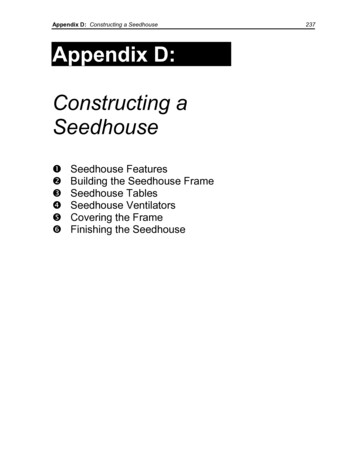

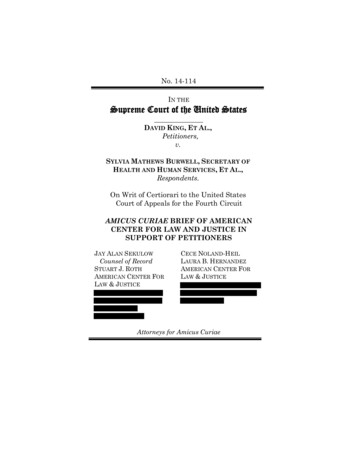
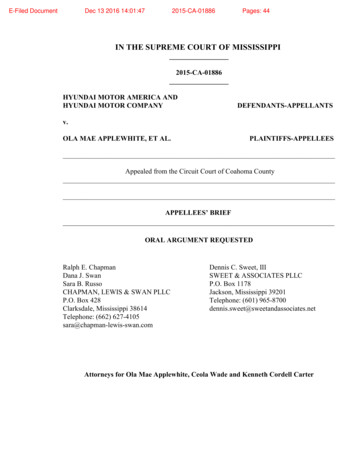
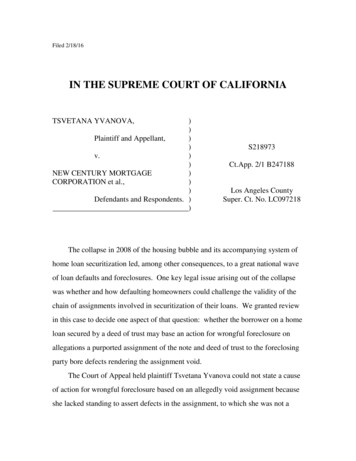
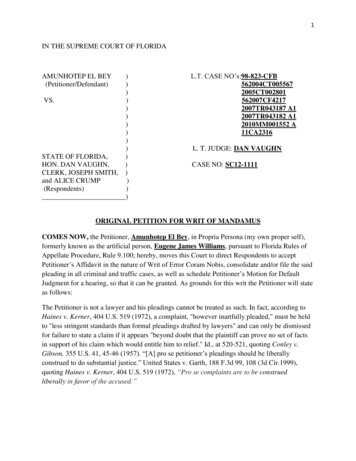
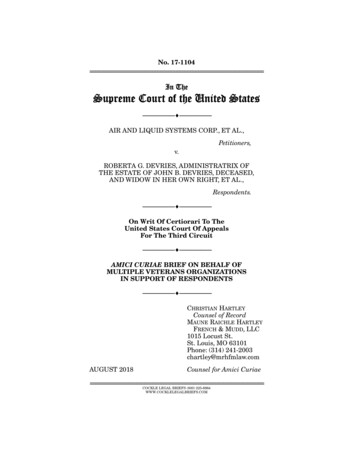
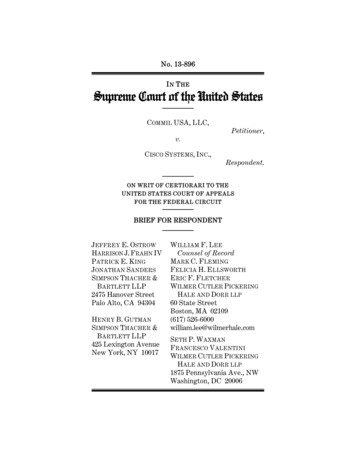
![IN THE SUPREME COURT OF T]-lE STATE OF MONTANA](/img/7/526b198c923f8.jpg)
